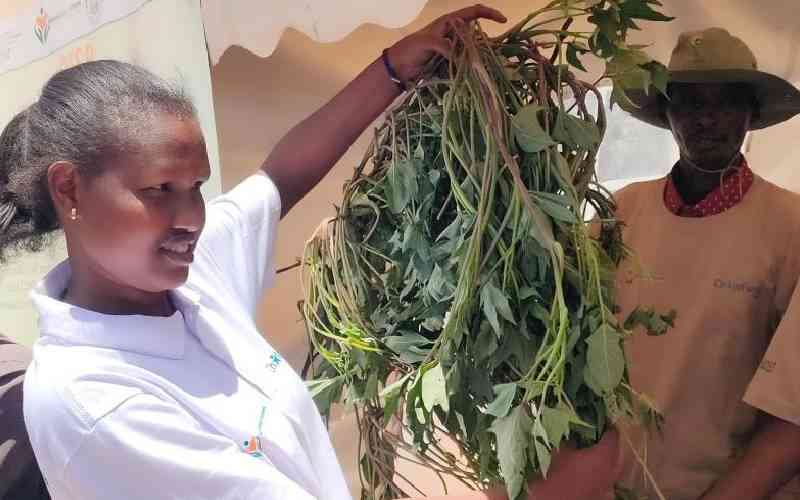 |
|
Nominated senator Naisula Lesuda(Right) chatting with a woman at her Samburu home |
By Benjamin Obegi
Samburu, Kenya: Samburu County evokes images of drought. Those long dry spells are often associated with this northern Kenya frontier largely inhabited by pastoralists.
However, the county has gained international attention for a more ignoble reason— the pervasive practice of Female Genital Mutilation (FGM).
However, the wind of change is sweeping through its vast plains and the tide against this repugnant practice is beginning to turn.
The assistant chief of Wamba sub-location, Samburu East, Patrick Lempwaketa, says though the illegal practice is generally accepted to most local Samburus, it is increasingly being isolated to the county’s more remote regions.
“Some gains have been made, which would indicate that public awareness campaigns are bearing fruit,” says Lempwaketa. “This has helped reduce the number of girls who leave school to get married at a tender age.’’ Early teenage pregnancies are also not as rampant.
A recent report, The State of the World Population 2013, titled, Motherhood in childhood: Facing the challenge of Adolescent pregnancy, highlights cases of early marriage, teenage pregnancies and points to the net effect on the girls with regard to education, health and future prospects.
The report, published annually by United Nations Fund for Population, UNFPA, points out how these bottlenecks deny the girl-child opportunities to positively contribute to the economy.
It notes that 20,000 girls below 18 years give birth daily in developing countries, while two million girls under the age of 15 give birth yearly. Furthermore, the report notes that 3.2 per cent of girls between the ages of 15 and 19 have unsafe abortions. About 95 per cent of adolescent pregnancies are found in developing economies where Kenya features.
These indices point to the danger facing the girl-child. In Kenya, the same report notes that 17.7 per cent of young women aged between 15 and 19 have had a child or are currently pregnant.
Rhoda Lolmodony, 65, of Wamba sub-location has “cut” thousands of girls during the last two decades. However, she says the number has been declining even during school holidays when the the “cut season” peaks.
“Many families now see their daughters, not as sources of dowry, but as valuable members of the society,’’ Lolmodony says.
These sentiments are shared by Fatuma Lekudere who observes that families have understood the dangers associated with female genital mutilation. Some girls have also converted to Islam to escape the cut.
A report on female genital mutilation released by the World Health Organisation in February notes that 140 million girls and women globally are living with the long-term consequences of female genital mutilation. The practice, accounts for growing cases of mortality in developing countries, Kenya included. In Africa, the fact sheet expounds, 101 million girls have undergone the cut. The cut is also responsible for the increasing cases of obstetric fistula.
But, this is beginning to change in Samburu County, says Maison Leshoomo, the Samburu County women representative.
Stay informed. Subscribe to our newsletter
“We are now focusing on remote areas where the practice is still very prevalent. But the battle is not about using force. We are cautiously creating awareness on the effects, especially the health impact on young girls. We have seen a reduction in early marriages in Samburu.”
Neisula Lesuda, a nominated senate representative in the area, says there has been too much generalisation about this illegal practice.
“The practice may be there but statistics vary from one location to another. To make generalisations is to fail to appreciate the positive gains that have been made. As leaders we are building on this impressive record,’’ says Lesuda . Towards this goal, the focus is now to educate the girl-child so that she can rescue herself.
Women leaders such as Leshoomo and Lesuda have been role models for the girls in anticipation that more students will stay in school and complete their education and resist to be lured into early marriage.
In releasing the recent population situation report, the UNFPA director general, Dr Babatunde Osotimehim, said: “Girls who remain in school longer are less likely to become pregnant. Education raises their self-esteem, status and gives them more say in decisions affecting their lives.’’ He notes that education reduces the incidences of child marriage and delays child bearing. Senator Lesuda agrees. “Role modelling is key in this battle. We want girls in villages and schools to look up to us as role models and success stories of people who have defied the age-old practice of the cut and early marriage. We are providing the girls with choice. Through this we can emancipate our girls.’’
Perhaps as a way to inspire girls in schools, nine young women leaders were nominated to the Samburu County assembly. Josephine Statian, 24, one of the nominated representatives, said: “Samburu girls need community examples they can identify with. We have beaten the odds to be here. Our girls need to find hope in us.’’
Boys have also been identified as a key plank in discouraging the cut and early marriage. The UNFPA report calls for boys to be encouraged into seeing girls as equals. Naomi Lekisat, 29, points that boys can play a role building the self-esteem of the Samburu girl.
“It is boys who expect that girls be circumcised before they marry them. It is important that boys begin to see girls as equals. Boys, therefore, remain crucial if we are to win,” says Lekisat.
In Samburu, girls are expected to be circumcised before getting married. Because of these expectations, girls often skip school to undergo the cut. Lekissat says she felt the pressure to be circumcised when classmates challenged her to prove her womanhood.
Moranism has also been identified as being the force behind girl circumcision and early marriage. Mosota Atunga, a post-graduate student at the University of Nairobi looking into aspects of the Samburu culture, says moranism encourages females to circumvent the law and accept the cut.
“As warriors for the tribe, Samburu morans occupy revered position in society. They carry the hopes and expectations of the community. To match this high place in society, the girl-child is expected to serve the morans. Morans will only take as their wives women who have been circumcised. This subjects the girl to pressure.’’
Education is key to reorienting this thinking, he says. “We need to break this bondage in order to free the Samburu girl-child. The faster we break away from the past the better for the Samburu girl,’’ says Atunga.
Previous studies have examined the role of moranism in pastoralist communities in relation to their contribution to female genital mutilation. Tobias Okoth Onyango, the Assistant County Commissioner at Wamba District, says this is a major impediment.
“The moran expectations exert pressure on girls who feel they have little choice but meet societal demands. By breaking loose these chains, society will remove the yoke from the backs of Samburu girls,” says Onyango.
Among the Samburu, men are the custodians of the community’s culture, therefore, renewed focus has been turned on them. Lesuda says: “Men still hold sway in our cultural issues.
We are now laying emphasis on having men as players in this crusade. We must educate men about the effects of this repugnant cultural practice. The barriers can be broken in a society where a man’s word is law . . . especially a society in which women religiously follow orders without questioning them.
Therefore, the battle against female genital mutilation and early marriage in Samburu has to be multi-faceted if progress is to be made. It can be won through less “masculinisation” of the community so that freedom of choice, especially for girls, is promoted.
The UNFPA director general said: “Building a gender-equitable society in which girls are empowered, educated, healthy and protected from child marriage, live in dignity and security and are able to make decisions about their futures and exercise their rights is essential.’’
—[email protected]
 The Standard Group Plc is a
multi-media organization with investments in media platforms spanning newspaper
print operations, television, radio broadcasting, digital and online services. The
Standard Group is recognized as a leading multi-media house in Kenya with a key
influence in matters of national and international interest.
The Standard Group Plc is a
multi-media organization with investments in media platforms spanning newspaper
print operations, television, radio broadcasting, digital and online services. The
Standard Group is recognized as a leading multi-media house in Kenya with a key
influence in matters of national and international interest.
 The Standard Group Plc is a
multi-media organization with investments in media platforms spanning newspaper
print operations, television, radio broadcasting, digital and online services. The
Standard Group is recognized as a leading multi-media house in Kenya with a key
influence in matters of national and international interest.
The Standard Group Plc is a
multi-media organization with investments in media platforms spanning newspaper
print operations, television, radio broadcasting, digital and online services. The
Standard Group is recognized as a leading multi-media house in Kenya with a key
influence in matters of national and international interest.









